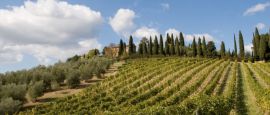Italy Weather, climate and geography
Weather & climate
Given its long boot-like shape and varied geography, the weather in Italy varies considerably from north to south. In the alpine north of the country, cold, harsh winters with heavy snowfall are typical between December and March, while summers are sunny and fresh. Around the northern Italian lakes, however, a mild microclimate prevails, benefitting the olive groves and tropical gardens that surround the lake, most of which come into spectacular bloom between April and June.
In central Italy, beyond the Tuscan-Emilian Apennines, the climate is milder and wetter with a less pronounced difference between summer and winter temperatures. Summer lingers longer and city centres, such as Florence, Siena and Rome can experience stifling humidity especially during July and August.
In the south, summers are far hotter and drier and temperatures more akin to those in North Africa prevail, often reaching above 30°C. Snow is rare and winter is especially mild, making the southern tip of the peninsula and the islands of Sicily and Sardinia ideal late season destinations.
Italy is characterised by a Mediterranean climate with hot, dry summers and cool, wet winters. July is the hottest month with temperatures up to 30C (86F), and January is the coldest month. It is a great destination to visit year round, particularly if taking a city break, though for the warmest and most reliable weather April to June is the prime tourist season. Most Italians take their holiday in July and August so prices, and crowds, can soar during these months, which are also the hottest of the year. If you’re keen to avoid the main scrum of peak season but still bank on mild weather, late September to October is a good choice.
Geography
Italy is a boot-shaped country situated in southern Europe. Jutting out into the Mediterranean Sea, it shares borders with France, Switzerland, Austria and Slovenia in the mountainous north, which contains some of the highest peaks in Europe.
In central Italy, Tuscany has a diverse landscape composed of fertile rolling hills, lush river valleys, minor mountain ranges and a long sandy coastline. To the east is Umbria, known as the ‘green heart of Italy' - hilly with broad plains, olive groves and pines, and Le Marche – a region of gentle mountains, rivers and small fertile plains.
Further south lies Rome, Italy's capital city. Within its precincts lies Vatican City, the world's smallest country (by landmass). The south of the country is hotter, wilder and much drier than the north, characterised by dry sierras, rocky mountain ranges and volcanic outcrops, including three of Europe’s most active volcanoes: Vesuvius, Etna and Stromboli.
Puglia, the ‘heel of the boot', is a mixed landscape of fertile plateaus, expansive olive groves and flat, ochre-coloured plains. The islands of Sicily and Sardinia lie offshore to the southwest and west respectively.
Do you have any Feedback about this page?
© 2025 Columbus Travel Media Ltd. All rights reserved. No part of this site may be reproduced without our written permission, click here for information on Columbus Content Solutions.





 You know where
You know where
